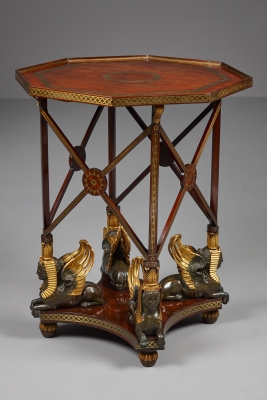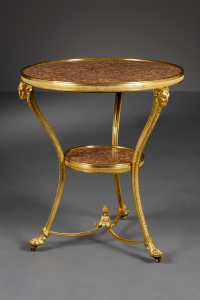Russian Guéridon, St. Petersburg, attributed to Heinrich Daniel Gambs
Russian Guéridon, St. Petersburg, attributed to Heinrich Daniel Gambs
A gueridon with an octagonal top with raised edge inlaid with decorative brass decoration. This tabletop is supported by four narrow solid mahogany columns connected by inlaid crossed joints. The columns rest on four carved, gilded and patinated sphinxes lying on a square plateau. The feet of the sphinxes gracefully curl over the edge of the plateau. The whole is supported by four solid mahogany feet with gilded knots.
Heinrich Gambs (1765-1831) was born in Württemberg Germany and started his career under David Roentgen. In the late 1780s he moved to St Petersburg where he founded a furniture workshop. Soon his name and fame grew and he could serve the elite of this city with the finest fashionable furniture. Already in 1793, Maria Feodorovna ordered a bureau with Gambs. This was the beginning of a long association with the tsar family. Catharina asked him in 1795 to decorate the apartments of her grandson Alexander and in 1801 he was appointed court cabinet-maker and was principally employed in supplying the Imperial residences, including Pavlovsk, Tsarsköe Selo and the Winter Palace.
Gambs has, as far as is known, not signed any furniture. Attributions are based on recurring elements such as material, shapes, and decoration. In particular, the decoration with a geometric brass ornament on a blackened background is a characteristic that is found in the mahogany furniture of Gambs. Heinrich Gambs had developed a technique in which certain parts of a piece of furniture were embellished with a band of dark wood inlaid with perforated brass fringes of varying widths. General characteristics were feet and arms in the form of eagles, griffins and sphinxes. His early furniture had these feet in painted or varnished and gilded wood. Later his furniture was decorated with bronze sculptures.
This Gueridon is probably after design by Andrei Voronikhin (1759-1814) the famous architect and designer, executed by Heinrich Gambs. Voronikhin and Gambs worked together on various occasions, especially in the design of Pavlovsk, the palace that was redecorated after the great fire of 1803.
The importance of Heinrich Gambs for the development of Russian furniture in the early nineteenth century has recently been described in Dr. Ugleva's book on the cabinetmaker and his family, According to Dr. Ugleva, Gamb's workplace was unique and leading in St Petersburg. Gambs had a major influence on the manufacturing of furniture throughout Russia during the nineteenth century, not only in terms of design, but also in a technical sense. Gamb's furniture was of the highest quality and therefore the name Gambs furniture was given a special meaning in the Russian language that reflected the high level of the firm. According to a Russian dictionary from that time, the name Gambs was not only a trademark, but it was also a synonym for precious, in other words with buying a Gambs they bought not only the article but also the feeling of the highest form of beauty, comfort and undoubtedly fashion and prestige.
Ugleva points out that the term ‘Gambs furniture’ became synonymous with luxury, wealth and taste and entered into literature from the 19th century classics, including Pushkin “dreaming in his Gambs chair” and Turgenev in Fathers and Sons who “sat long after midnight, in a wide Gambs Chair, in front of the fireplace;” the expression even entered into one of the most famous of Soviet literary works The Twelve Chairs by Ilf and Petrov
These qualities of Gambs furniture are hilariously referred to in Gogol’s Dead Soulswhere the narrator speculates on the possible reasons someone might wish to accumulate wealth by dishonest means: “every one of us has his weakness. . .another steals from his own children for the sake of some airheaded actress. . .or for the sake of some Gambs furniture. . .what can you do with so many of all sorts of temptations in the world…”
This gueridon is a gift from Tsar Nicholas II to the Spanish ambassador in St. Petersburg, the 7th Earl of Villagonzalo, Mariano Miguel Maldonado y Davalos (1851-1901). He was appointed as an accredited representative on behalf of the Spanish crown in 1891. This function was converted into Ambassador in 1896, with which Villagonzalo became the first ambassador of Spain in the Russian empire.
During his stay in St Petersburg, a warm friendship arose between Tsar Nicholas II and Villagonzalo. The tsar even mentions him in his diaries:
“Saturday 20th April, 1896. The day was marvellous and bright. The two of us went on a short walk and found masses of anemones. After breakfast I received Count Vollagonzalo [sic], previously the Spanish representative, now the ambassador here.”
This is a sign of the fact that they were friends and did not deal with each other in a purely business-like way. The Tsar's diaries never deal with such visits, which he probably received daily, only when it was friendly it was written down in his personal diaries.
In 1899 Villagonzalo received the imperial order of Alexander Nevsky. This knighthood has followed the vicissitudes of Russian history over the centuries. The Order has existed in two forms in the empire of the tsars and in the Soviet Union and is now, in a third appearance, an order of the Russian Federation.
The order was reserved for high soldiers among the tsars. The assignment of this order, as with the other Russian orders, meant that the bearer was elevated to the Russian nobility. It is therefore extremely exceptional that the Spanish ambassador got this order.
The 7th Earl of Villagonzalo was an avid collector of art. He possessed, among other things, a large collection of paintings. As described above, the name Gambs in Russia at the end of the nineteenth century was still a synonym for quality. This gift from the tsar was not just a present. It was a very precious gift that was cherished by the Villagonzalo heirs for more than a hundred years.
Comparative literature:
N.V. Ugleva, Heinrich Gambs Furniture, Moscow 2016.
A. Chenevière, Russian Furniture, The Golden Age 1780-1840, London 1988, reprinted 2001
- Provenance
- Gift from Tsar Nicholas II of Russia to the 7th Count of Villagonzalo, Mariano Miguel Maldonado y Davalos (1851-1901), Spanish ambassador in St Petersburg 1893-1897,
Thence by descent - Period
- ca. 1810
- Material
- pine veneered with mahogany, brass inlaid, patinated and parcel gilt carved wood sphynxes
- Dimensions
- 78 x 63 x 63 cm
Global shipping available










